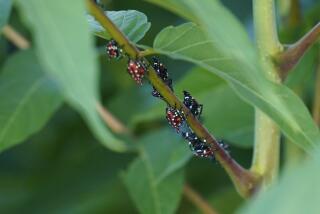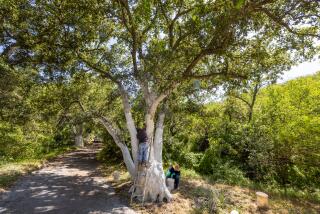Will Beetle Bombs Recapture Everglades--or Overrun It?
- Share via
MIAMI — A voracious predator from a distant antipodean world has been roaming the marshlands of South Florida for about six weeks now.
Before its release, many residents were fearful. But eight years of laboratory study convinced scientists that the confetti-sized Australian weevil would eat only the pesky melaleuca trees, and eventually public apprehension subsided. So in April, about 700 of the tiny snout beetles--each marked on its underside with a dollop of paint--were turned loose in the Everglades.
Early reports are promising. “They are doing well,” said entomologist Ted Center of the U.S. Department of Agriculture on Monday. “We set some in a clump of about 100 trees, and every single tip on every branch in that clump has been destroyed by bugs.
“We have also found two unmarked weevils, indicating that they are reproducing.”
This past weekend, however, House Speaker Newt Gingrich (R-Ga.) took a spin through the sawgrass on an airboat and, while vowing his support for Everglades restoration, made an off-the-cuff remark comparing the introduction of the beetle to what he called the “Jurassic Park” effect. Wondering aloud about the danger of adding another exotic animal to the fecund subtropical stew of life, Gingrich noted that the mongoose imported to the Caribbean years ago for control of rats is now killing native birds.
Well, Center said, “that Jurassic Park comment hasn’t helped at all. Paralleling the insect with a dinosaur really bothers me. Newt’s comment will cause us to have to explain again and again and again.
“This is a very safe approach. Worldwide, more than 200 species of insects have been introduced for weed control, 14 in Florida, and there have been virtually no unintended effects. Insects don’t eat everything.”
Still, the notion that an exotic species set loose to solve one problem turns into an even bigger problem is not just the stuff of thriller fiction. The melaleuca tree, for example, was widely planted in Florida to dry up unwanted wetlands, just as its Australian cousin, the blue-gum eucalyptus, was planted throughout California as a potential source of lumber. Both proved to be expensive mistakes.
But scientists, the public and Gingrich--a former environmental studies professor--are more mindful of unwanted consequences now. After years of studies and careful quarantine, Center said, “I have perfect faith in this insect’s safety. We would not have proceeded with releasing it unless we were certain.”
Center’s confidence comes from a wealth of evidence that Oxyops vitiosa eats melaleuca buds and leaves, and only that.
Moreover, Center said, the gray-brown bug is unlikely to skew the delicate balance of nature by becoming another creature’s favorite food because it secretes “an oil which forms a slimy layer over its body.
“It probably tastes bitter. Even fire ants won’t touch it.”
Although the snout beetle is science’s best hope against the melaleuca, which has crowded out native species and interfered with alligator nesting while taking over about 600,000 acres of South Florida wetlands, it is not the only biological weapon waiting to be unleashed. Researchers also have several other insects in quarantine, including a melaleuca-munching saw fly that could be set free within two years, Center said.
Restoring the imperiled Everglades ecosystem--compromised by exotic plants, pollution from farm runoff and canals that have altered the natural water flow--is now a bipartisan concern in Washington. The Clinton administration budget for the next fiscal year makes rescuing the Everglades the largest environmental project in U.S. history. And Gingrich backed a $200-million addition to the farm bill for buying up adjacent wetlands.
Yet when it comes to using bugs to atone for human error, “there is so much entomophobia out there,” Center said. “Already I have heard rumors that this beetle is attacking citrus. Not true.”
More to Read
Sign up for Essential California
The most important California stories and recommendations in your inbox every morning.
You may occasionally receive promotional content from the Los Angeles Times.










